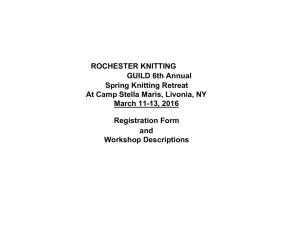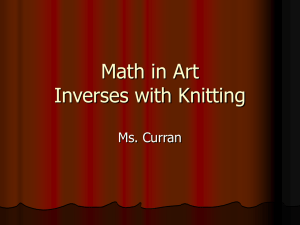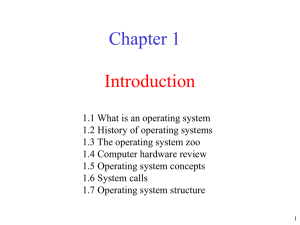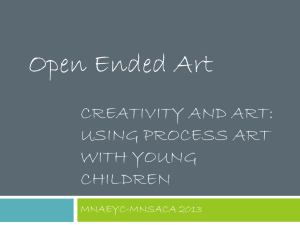CAD/CAM in Knitting
advertisement
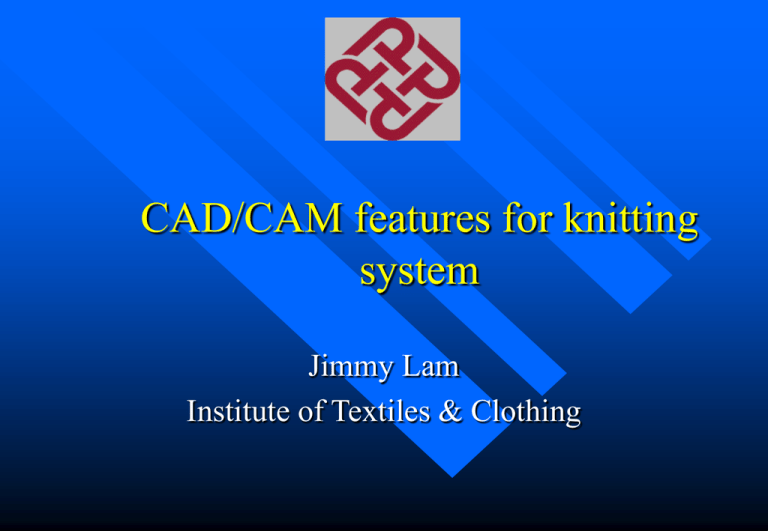
CAD/CAM features for knitting system Jimmy Lam Institute of Textiles & Clothing Learning Objectives Principle of electronic control in knitting Numerical and computer control system Modern control elements in knitting machine Circular Machine CAD/CAM are mainly used for jacquard single or double jersey knitting on large diameter circular knitting machines. The content of CAM in piece goods are: * The memory of the controller – The very large memory of the machine built in computer can hold up a few different patterns, which can be called up at any time, or mixing of patterns during knitting. The preparation of jacquard patterns are normally done on CAD units and the final patterns are stored in the data carriers for the knitting machine to read. * Shifting of colours on jacquard fabric. – Before knitting, colour yarns are placed on the machine in specified orderlike » feeder no 12345678 » yam colour AB C DAB C D – If the same pattern has to be knitted with different combination of colour such as; » feeder no 1 2 3 4 5 6 7 8 and yarn colour B C DJ A B C D or » feeder no 1 2 3 4 5 6 7 8 and yam colour C D A B C D A B or » feeder no 1 2 3 4 5 6 7 8 and yam colour D A B C D A B C Principle 2. Computer » The flexibility of making decision, process data (yes or no) make it ideas for counted loop sequence, branching or jumping operation. » ie. Electronically controlled knitting pattern preparation and needle selection 3. Computer Hardware and software – Hardware : electronic, magnetic and mechanical device – Software : programme and documentation for the system 4. – – – Main Sections of Computer CPU; Memory; Peripheral Interface 5. Input & output device – Input: sensors on knitting machine; keyboards, light-pen; tapes and discs. – Output : actuators on knitting machine, light; digital and graphic display; tapes and printer. 6. Memory: ROM and RAM » » Read only memory (ROM), non-voltaile, cannot be erased. Hold important program and is programmed in manufacturing. » Others: PROM and EPROM Read and Write Memory (RAM) – Is voltaile and data can be erased. – Use to store data and programme during processing. – Two types: Static RAM and Dynamic RAM 7) Knitting machine program and control – Electronic machine eliminates all punch cards, chains, rack wheel, peg drum, element but which are expensive and bulky. – Interactive computer graphics enable designer draws pictures and display on the screen. Colour can be added/changed immediately. Pattern can be rotated, stretch, mirror and scale. Designer can freely explore his/her ideas using the computer tools Modern V-bed Knitting Machine Control Machine Control The modern V-bed m/cs abandoned the pasteboard card control because: The electronic parts are cheaper to produce than the mechanical parts; Numerical is more accurate and very fast in response; Programs are easy to file or store; – Easy to duplicate the programs Two control methods Numerical and computer control Numerical Control They are the simple control for non-jacquard knitting. It contains a control panel with function keys and control knobs for data input. The major advantages is that no pasteboard card and hole punching is needed. Computer Control Computer Control – The numerical control is only good for simple knit collars, rib straps and body panels without pattern. Once individual needle selection is involved, computer control must be used. Modern electronic V-bed m/c has : – Central Processing Unit: The brain of m/c control with data like pattern, machine control, economizer, pattern development. – Keyboard : This is used for giving command or make modification. – Tape/Floppy reader : The pattern and data input device – Visual Display Unit : A monitor to display all information of the knitting machine. Example :Shima Seika The modern electronic V-bed m/c (says, Shima Seika), divided the systems into 6 sections, namely Control tape; Pattern tape; Pattern development tape; Stitch tape; Economize tape; and Yarn carrier tape Shima Seika Control System 1 – 2. – 3. – Control tape Similar to punch card in mechanical machine, it is a one inch paper tape with 8 row holes. The tape is divided into block, one block is the same as one punch tape. Pattern tape This sector contains all the pattern details. The design is normally created in a CAD system and is now transferred as a series of holes in the punch tape. The length of tape will depend on the pattern size, the longer the design, the longer will be the tape. Pattern development tape This is to control the location of the pattern onto the fabric. It can be mirror the design or repeat the design horizontal/vertically etc. See Figure Shima Seika Control System 4. – 5. – 6. – – Stitch tape This is used to control the stitch length (loop length) of the fabric. Modern Vbed m/c could have over 30 different setting in the memory for different material and structure design. Economizer tape The economizer on the mechanical V-bed is to use the minimum number of pasteboard cards for sweater panel. For the electronic machine with computer control, the system can memorize all the repeat structure and sort out the necessary cards or blocks in the design automatically. Yarn Carrier tape In cut and sewn panel, the yarn carriers are set at fixed places about 2 to 4 cm away from fabric selvedge. For fully fashioning panel (or intersia), the knitting width is changing all the time, the yarn carriers must stop in varies position. The stopping of yarn carriers is controlled by the computer which is either changes the location of the carrier stoppers on the rails or commands the cam carriage to release the working yarn carriers at specific location above the needle Discussion Discuss the different between numerical and computer control system List out the five control systems found in Shima Seika Electronic knitting machine



